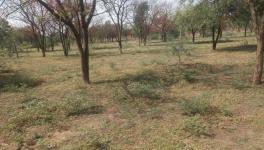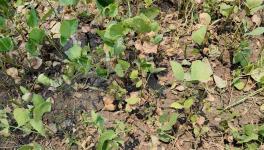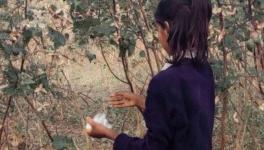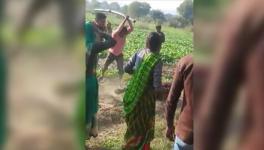The Role of the Community in the Lesser Florican's Conservation
Lesser Florican display Shokhaliya by Sujit Narwade.
Communities play a big role in the conservation of any species. Without community support, the relentless efforts of forest officials and wildlife scientists and experts may end in waste. The case of the conservation of the Lesser florican (LF) – a bird species – which had been disappearing from Madhya Pradesh despite having two wildlife sanctuaries dedicated to them, mainly due to the antagonism of the local community, shows so. On the other hand, the support of the local community has made it possible for the Rajasthan Forest Department to plan a community and conservation reserve for LF conservation in the district of Ajmer.
Lesser florican(Sypheotides indicus), an open grassland and scrub-land species, is the smallest of India’s three resident bustards. The other two are the Bengal florican and Great Indian bustard. It falls under the category of critically-endangered species under the IUCN Red List and accorded the highest degree of protection under Schedule 1 of The Wild Life (Protection) Act, 1972.
As per a survey carried out by the Wildlife Institute of India (WII) in 2018, there are 264 Lesser Floricans left in the country; an almost 80% decline in their population since 2000 when around 3,500 individuals inhabited the five states of Rajasthan, Madhya Pradesh, Gujarat, Maharashtra and Andhra Pradesh.
While Rajasthan and Gujarat are doing comparatively well, the situation does not look good in Madhya Pradesh and Maharashtra.
According to a report prepared by the Bombay Natural History Society (BNHS) in 2020 with regard to a conservation plan for the Shokaliya landscape in Ajmer, one of the most prolific sites for LF breeding, the birds were mainly seen in the croplands as the majority of the common grazing lands were full of Prosopis juliflora, an invasive plant which is unsuitable for the species.
Lesser Florican display photo by Sujit Narwade
Areas with traditional crops like Jowar, Moong and Urad, growing up to a height of 50 to 100 cm, were seen as preferred by these birds. Disturbance due to mechanical operations while farming, widespread use of chemical fertilisers and pesticides, overgrazing in kankads (common grazing lands) were observed as major threats to the breeding birds. Uncontrolled tourism, an increase in free-ranging dogs, land-use changes, chemical spray and unavailability of grasslands were found as some of the important threats to be addressed immediately, according to the report.
“The support of local people is must for the survival of LFs. The birds visit Ajmer because of the self-management of grazing land by local communities and traditional crops preferred by farmers, which needs to be supported by government agencies,” Sujit Narwade, project scientist at BNHS, told Newsclick.
“The birds prefer traditional crops like jowar, moong and urad so that they can spot predators given that the crops are at a comfortable height and the female birds can see the males putting on an aerial display during the breeding season,” he said.
He added that a sensitisation program to enable a discussion on the conservation of LF – called Kisan Chaupal – was organised jointly by the forest department, State Biodiversity Board of Rajasthan and BNHS, which was attended by local villagers.
A detailed project report for a conservation reserve spread across 893 ha of reserve forest spanning the three villages of Arwar, Goyala and Kheeriya in Ajmer district, has been prepared. “We are also in the process of preparing a Community Reserve for LF conservation. As part of the latter the farmers will own the land but in both cases, public consultation will be held. In case of the community reserve, a committee of local people headed by the sarpanch of the village will be constituted The entire process, which include lots of documentation and approvals, will take some time to start,” he added.
The recommendations enlisted in the DPR say Florican distribution sites, other than the Protected Areas, can be developed as Florican Community Conservation Areas (FCCA) or Florican community reserves. There are proposed restrictions on habitat alteration, mining, industrialisation, establishment of non-renewable energy projects and installation of power lines. Habitat restoration work should be carried out on government-owned land. To avoid overgrazing, some of the plots can be managed by rotational grazing. If nesting is observed on a chunk of land of a local farmer, he/she should be subsidised for the same, the recommendations mentioned.
During the breeding period, it must be ensured that there is less disturbance to the display and nesting sites. Sensitising the local people is crucial for this.
M.K. Ranjitsinh Jhala, the legendary conservationist and prime architect of the Wildlife Protection Act, told Newsclick that the Rajasthan forest department could “rather create a wildlife sanctuary instead of a Conservation Reserve, where better protective measures such as restriction on grazing and outside disturbance, could have been better implemented.”
However Narwade said restrictions make people suspicious and antagonistic. He further endorsed his view by saying that birds which do not go by limits of boundaries often move to other territories with better rainfall.
During the 1990s, there were around 55 Great Indian Bustards (GIB) reported in this landscape, a number which reduced to four birds in 2016 and, unfortunately, no confirmed sightings thereafter. It is hoped that the LF will not go the way of the GIB and efforts are on for its conservation through traditional farming practices, with the help of the concerned agencies.
Narwade estimated around 48 LF inhabit Shokaliya and its surrounding villages.
The LF is relinquishing Madhya Pradesh for various reasons, including habitat loss, pesticide use in farmland, overgrazing and, the local community’s opposition. Around 11 LF were sighted in the state a couple of years ago. Two wildlife sanctuaries – Sardarpur Kharmor Sanctuary and Sailana Sanctuary – in the Dhar district of MP were dedicated to the LF . In Sardarpur, farmers from 14 villages who own over 200 sq kms of private land within 38.12 sq km area of the sanctuary were agitated and demanded lifting the ban on land sale. They are also upset about restrictions enforced on the development of infrastructure within the sanctuary.
Alok Kumar, IFS, Principal Chief Conservator of Forest (Wildlife) & Chief Wildlife Warden, Madhya Pradesh Forest Department, told Newsclick: “Our proposal with regard to de-notifying the private land inside Sardarpur Sanctuary area, which belongs to villagers and which also sighted a negligible presence of LF in the last two to three years, has been approved by the State Wildlife Board and National Wildlife Board. Now, a Central Empowered Committee has been decreed by the Supreme Court to decide on such matters, is yet to give its verdict. We have amalgamated some additional contiguous patch of forest land in the vicinity. Hopefully, we will be able to resolve the stalemate with the community people with this. ”
“It is fine if the land has been de-notified to quell the discontent of local people, but forest officials must delineate and enforce concrete plans for LF conservation in the existing area,” said Ranjitsinh.
Sailana Wildlife Sanctuary has sighted no LFs for the past three years. Amar Singh Rathod, a local naturalist, explained to Newsclick: “I have been going to quite frequently since my childhood. I had witnessed a good number of Lfs (50 to 60) here till the year 2009. Since then, their numbers continued dwindling as local farmers began converting grassland to farmland,” he said.
He said the eggs which this species lays on the ground are susceptible to being trampled by cattle and bull as well as by farmers when they harvest their crops in the beginning of the Monsoon season. This is the time for the birds’ arrival for breeding. “The forest department has a scheme to compensate farmers to leave their farm land for four months during the breeding season (July to October) if they sight any LF eggs lying there. However barring a couple of cases, the farmers do not share such information with the forest department,” he added.
The MP forest department is now making a last-ditch attempt to save the birds through conservation breeding. The forest department has sent out a proposal to the State Wildlife Board to build and run a conservation breeding centre with the expertise of Salim Ali Centre for Ornithology and Natural history (SACON).
“The GIB and Lesser floricans are flagship species of the grassland. The forest department can galvanise farmers not to cut grass during the Monsoon season when these birds lay eggs on the ground and that they harvest the grass only when they leave with their chicks at the end of the monsoon in October,” said Ranjitsinh.
(The writer is an independent journalist.)
Get the latest reports & analysis with people's perspective on Protests, movements & deep analytical videos, discussions of the current affairs in your Telegram app. Subscribe to NewsClick's Telegram channel & get Real-Time updates on stories, as they get published on our website.
























